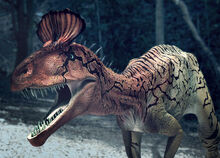Antarctica was once a warm tropical paradise, and it was home to Cryolophosaurus and Glacialisaurus.

The predatory Cryolophosaurus.
Description of the Landscape[]
Several techniques have been used to deduce the ancient climate of Gondwana in the Early Cretaceous. One technique involves looking at the levels of oxygen isotopes in the rocks from the time. These have suggested estimated mean annual temperatures of between 0 and 8 °C (32 and 46 °F). The rocks with associated mammal and dinosaur fossils show evidence of permafrost, features such as ice wedging, patterning and hummocked ground. Permafrost today occurs in temperature ranges of between −2 and 3 °C (28 and 37 °F).
Another method used to deduce the climate of the time is to use the types of plants found in the fossil record. The fossil record shows a floral community dominated by conifers,ginkgoes, ferns, cycads, bryophytes, horsetails and a few flowering plants. The plants indicated, through structural adaptations, a seasonal cold period and a mean annual temperature around 10 °C (50 °F) (higher than found by the oxygen isotope data) and the presence of ferns and bryophytes indicates rainy conditions. A large inland sea that extended into central Australia modified its continental climate. The very lopsided distribution of land and ocean around the South Pole would have forced the ocean currents and seasonal winds (monsoons) to flow across the polar area, stopping a cold pool from forming around the pole.
These studies show that during the Cretaceous there were no polar ice caps, and forests would have extended all the way to the South Pole, and life could have flourished there during the summer. However, the Earth's axial tilt means that the regions inside the Antarctic circle would still have experienced a polar night: a period of sunless darkness and cold of up to six months, during which only the hardiest life forms could survive. This combination of a habitable terrain with a long polar night is an ecological circumstance that has no present day analogue.

Cryolophosaurus in it's natural habitat.
Wildlife[]
The wildlife in Jurassic Antarctica were limited due to paleontologist having limited time digging up fossils for the Mesozoic Era. Here is a list of known Mesozoic creatures:
A crow sized pterosaur
Two mammal like reptile species
A unknown theropod
